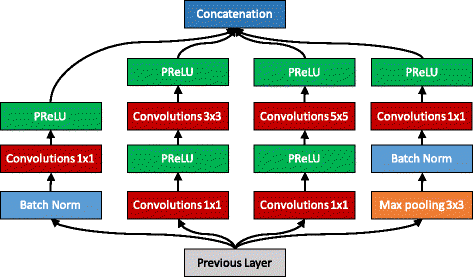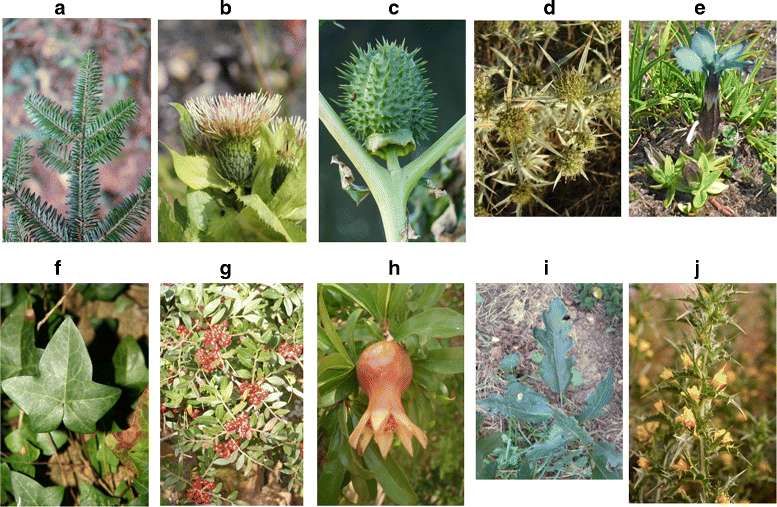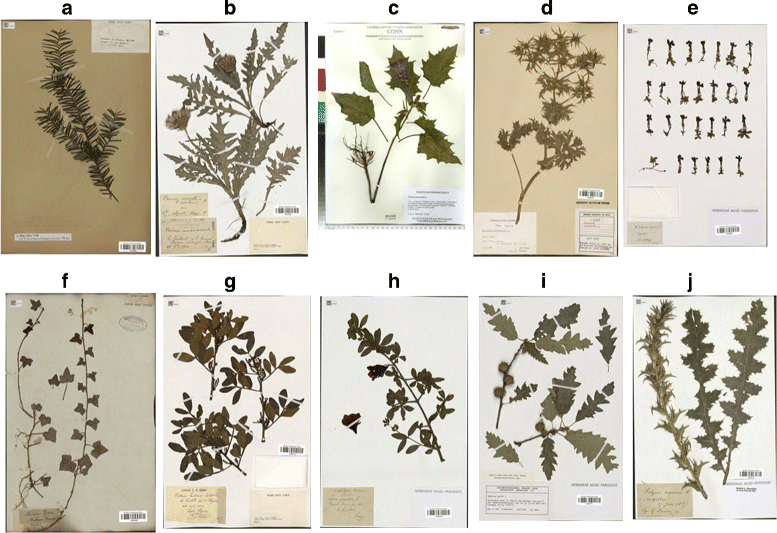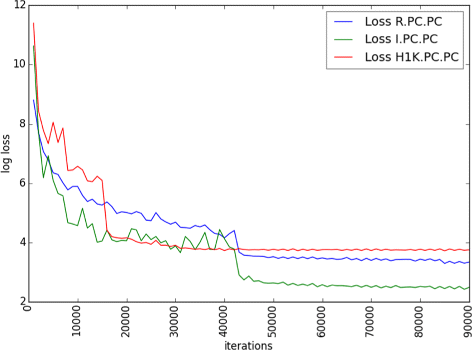Going deeper in the automated identification of Herbarium specimens
- PMID: 28797242
- PMCID: PMC5553807
- DOI: 10.1186/s12862-017-1014-z
Going deeper in the automated identification of Herbarium specimens
Abstract
Background: Hundreds of herbarium collections have accumulated a valuable heritage and knowledge of plants over several centuries. Recent initiatives started ambitious preservation plans to digitize this information and make it available to botanists and the general public through web portals. However, thousands of sheets are still unidentified at the species level while numerous sheets should be reviewed and updated following more recent taxonomic knowledge. These annotations and revisions require an unrealistic amount of work for botanists to carry out in a reasonable time. Computer vision and machine learning approaches applied to herbarium sheets are promising but are still not well studied compared to automated species identification from leaf scans or pictures of plants in the field.
Results: In this work, we propose to study and evaluate the accuracy with which herbarium images can be potentially exploited for species identification with deep learning technology. In addition, we propose to study if the combination of herbarium sheets with photos of plants in the field is relevant in terms of accuracy, and finally, we explore if herbarium images from one region that has one specific flora can be used to do transfer learning to another region with other species; for example, on a region under-represented in terms of collected data.
Conclusions: This is, to our knowledge, the first study that uses deep learning to analyze a big dataset with thousands of species from herbaria. Results show the potential of Deep Learning on herbarium species identification, particularly by training and testing across different datasets from different herbaria. This could potentially lead to the creation of a semi, or even fully automated system to help taxonomists and experts with their annotation, classification, and revision works.
Keywords: Biodiversity informatics; Computer vision; Deep learning; Herbaria; Plant identification.
Conflict of interest statement
Ethics approval and consent to participate
This study included no data or analysis requiring special consent to conduct or to publish.
Consent for publication
Not applicable.
Competing interests
The authors declare that they have no competing interests.
Publisher’s Note
Springer Nature remains neutral with regard to jurisdictional claims in published maps and institutional affiliations.
Figures







Similar articles
-
Computer vision applied to herbarium specimens of German trees: testing the future utility of the millions of herbarium specimen images for automated identification.BMC Evol Biol. 2016 Nov 16;16(1):248. doi: 10.1186/s12862-016-0827-5. BMC Evol Biol. 2016. PMID: 27852219 Free PMC article.
-
Automated Extraction of Phenotypic Leaf Traits of Individual Intact Herbarium Leaves from Herbarium Specimen Images Using Deep Learning Based Semantic Segmentation.Sensors (Basel). 2021 Jul 2;21(13):4549. doi: 10.3390/s21134549. Sensors (Basel). 2021. PMID: 34283110 Free PMC article.
-
An algorithm competition for automatic species identification from herbarium specimens.Appl Plant Sci. 2020 Jul 1;8(6):e11365. doi: 10.1002/aps3.11365. eCollection 2020 Jun. Appl Plant Sci. 2020. PMID: 32626608 Free PMC article.
-
The use and misuse of herbarium specimens in evaluating plant extinction risks.Philos Trans R Soc Lond B Biol Sci. 2018 Nov 19;374(1763):20170402. doi: 10.1098/rstb.2017.0402. Philos Trans R Soc Lond B Biol Sci. 2018. PMID: 30455216 Free PMC article. Review.
-
Automated plant species identification-Trends and future directions.PLoS Comput Biol. 2018 Apr 5;14(4):e1005993. doi: 10.1371/journal.pcbi.1005993. eCollection 2018 Apr. PLoS Comput Biol. 2018. PMID: 29621236 Free PMC article. Review.
Cited by
-
Can Artificial Intelligence Help in the Study of Vegetative Growth Patterns from Herbarium Collections? An Evaluation of the Tropical Flora of the French Guiana Forest.Plants (Basel). 2022 Feb 16;11(4):530. doi: 10.3390/plants11040530. Plants (Basel). 2022. PMID: 35214863 Free PMC article.
-
Using deep learning artificial intelligence for sex identification and taxonomy of sand fly species.PLoS One. 2025 Apr 3;20(4):e0320224. doi: 10.1371/journal.pone.0320224. eCollection 2025. PLoS One. 2025. PMID: 40179129 Free PMC article.
-
Using a Convolutional Siamese Network for Image-Based Plant Species Identification with Small Datasets.Biomimetics (Basel). 2020 Mar 1;5(1):8. doi: 10.3390/biomimetics5010008. Biomimetics (Basel). 2020. PMID: 32121572 Free PMC article.
-
Detection and annotation of plant organs from digitised herbarium scans using deep learning.Biodivers Data J. 2020 Dec 10;8:e57090. doi: 10.3897/BDJ.8.e57090. eCollection 2020. Biodivers Data J. 2020. PMID: 33343217 Free PMC article.
-
Applying machine learning to investigate long-term insect-plant interactions preserved on digitized herbarium specimens.Appl Plant Sci. 2020 Jul 1;8(6):e11369. doi: 10.1002/aps3.11369. eCollection 2020 Jun. Appl Plant Sci. 2020. PMID: 32626611 Free PMC article.
References
-
- Tschöpe O, Macklin JA, Morris RA, Suhrbier L, Berendsohn WG. Annotating biodiversity data via the internet. Taxon. 2013;62(6):1248–58. doi: 10.12705/626.4. - DOI
-
- Duckworth WD, Genoways HH, Rose CL, Association of Systematics Collections. National Institute for the Conservation of Cultural Property (U.S.) Society for the Preservation of Natural History Collections. Conservation and Preservation of Natural Science Collections Project . Preserving natural science collections : chronicle of our environmental heritage. Washington: National Institute for the Conservation of Cultural Property; 1993.
-
- Thiers B. Index Herbariorum: a global directory of public herbaria and associated staff. 2017. http://sweetgum.nybg.org/science/ih/. Accessed 1 June 2017.
-
- Ellwood ER, Dunckel BA, Flemons P, Guralnick R, Nelson G, Newman G, Newman S, Paul D, Riccardi G, Rios N, Seltmann KC, Mast AR. Accelerating the digitization of biodiversity research specimens through online public participation. BioScience. 2015;65(4):383. doi: 10.1093/biosci/biv005. - DOI
-
- iDigBio. 2017. https://www.idigbio.org/. Accessed 1 June 2017.
MeSH terms
LinkOut - more resources
Full Text Sources
Other Literature Sources

